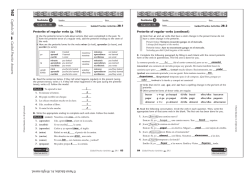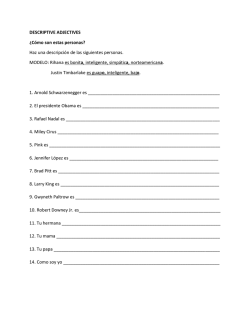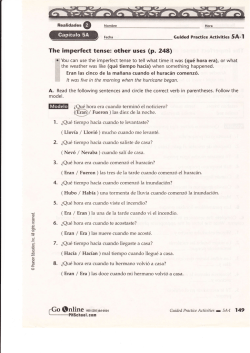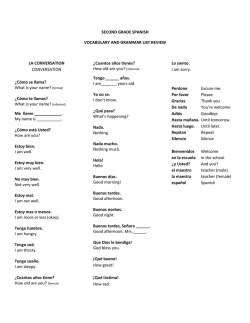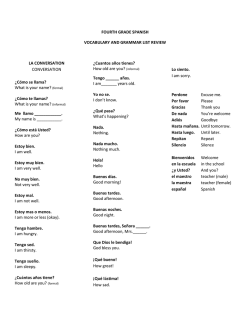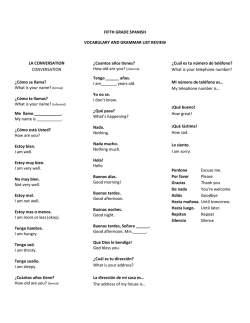
Capítulo 2A Guided Practice Answers
© Pearson Education, Inc. All rights reserved. Realidades Nombre Realidades Hora Fecha Guided Practice Activities 2A-1 Reflexive verbs (p. 80) me seco tú usted/él/ella Hora Fecha Guided Practice Activities 2A-2 Reflexive verbs (continued) • You use reflexive verbs to say that people do something to or for themselves. All reflexive verbs in the infinitive form end with -se. For example, secarse el pelo means “to dry one’s hair.” • The reflexive pronouns are me, te, se, os, and nos. Here is the present-tense form of the reflexive verb secarse: yo Nombre nosotros/nosotras nos secamos te secas vosotros/vosotras os secáis se seca ustedes/ellos/ellas se secan • Some verbs can be used in reflexive and non-reflexive forms. Me lavo el pelo todos los días. I wash my hair every day. Lavo el coche. I wash the car. C. Read these sentences. First, circle the whole verb (for example, lavo or me despierto). Then, write if it is reflexive [R] or non-reflexive [N]. Follow the model. Modelo El ruido despierta el perro. N ______ A. Look at the underlined word(s) and circle the correct reflexive pronoun for each sentence. 1. Ellos ( nos / se ) lavan el pelo. 1. Me despierto a las seis. ______ R 4. Yo me lavo la cara. 2. El chico pinta las paredes. ______ N 5. Yo lavo el carro de mis padres. ______ N 3. La chica se pinta las uñas. R ______ R ______ 2. Tú ( te / se ) pintas las uñas. 3. Javier y yo ( nos / se ) preparamos. 4. Roberto ( nos / se ) viste. 6. Lola y Rita ( se / nos ) arreglan. Guided Practice Answers © Pearson Education, Inc. All rights reserved. 7. Maya ( te / se ) acuesta tarde. 8. Tú ( te / me ) secas el pelo. B. Write the correct reflexive pronoun and form of the verb in parentheses to complete each sentence. Follow the model. Modelo (despertarse) Yo siempre me D. In each sentence, the reflexive pronoun is placed either before the conjugated verb or attached to the infinitive. Rewrite the sentence you are given using the other order without changing the meaning of the sentence. The first one is done for you. despierto a las 6:30. nos _______________ duchamos 1. (ducharse) Nosotras ______ a las 7:00 de la mañana. Elena tiene que maquillarse. 1. Elena se tiene que maquillar. _________________________________________________ me _______________ arreglo 2. (arreglarse) Yo ______ el pelo a las 7:30 de la mañana. José va a ducharse. 2. José se va a duchar. _________________________________________________________ te _______________ cepillas 3. (cepillarse) Tú ______ los dientes todos los días. Yo me voy a arreglar el pelo. 3. Yo voy a arreglarme el pelo. __________________________________________________ acuesta 4. (acostarse) Sandra ______ temprano durante la semana. se _______________ 5. (secarse) • Reflexive pronouns can be placed before the conjugated verb or attached to the infinitive. These two sentences have the same meaning: Me voy a duchar. or Voy a ducharme. I am going to take a shower. © Pearson Education, Inc. All rights reserved. Capítulo 2A 5. Yo ( me / se ) baño. 4. Elena e Isabel siempre se tienen que preparar lentamente. Ellas siempre tienen que prepararse lentamente. ___________________________________________________________________________ se _______________ secan Uds. ______ después de ducharse. Tu te acabas de vestir. 5. Tú acabas de vestirte. ________________________________________________________ 125 i\Xc`[X[\j%Zfd Guided Practice Activities 2A-1 65 66 Guided Practice Activities • Web Code: jdd-0204 REL211se_VG_GP02_053-070.indd 13 2A-2 i\Xc`[X[\j%Zfd • Web Code: jdd-0204 2/5/09 11:14:31 AM REL211se_VG_GP02_053-070.indd 14 2/5/09 11:14:32 AM © Pearson Education, Inc. All rights reserved. Realidades Nombre Realidades Hora Fecha Guided Practice Activities 2A-1 Reflexive verbs (p. 80) me seco tú usted/él/ella Hora Fecha Guided Practice Activities 2A-2 Reflexive verbs (continued) • You use reflexive verbs to say that people do something to or for themselves. All reflexive verbs in the infinitive form end with -se. For example, secarse el pelo means “to dry one’s hair.” • The reflexive pronouns are me, te, se, os, and nos. Here is the present-tense form of the reflexive verb secarse: yo Nombre nosotros/nosotras nos secamos te secas vosotros/vosotras os secáis se seca ustedes/ellos/ellas se secan • Some verbs can be used in reflexive and non-reflexive forms. Me lavo el pelo todos los días. I wash my hair every day. Lavo el coche. I wash the car. C. Read these sentences. First, circle the whole verb (for example, lavo or me despierto). Then, write if it is reflexive [R] or non-reflexive [N]. Follow the model. Modelo El ruido despierta el perro. N ______ A. Look at the underlined word(s) and circle the correct reflexive pronoun for each sentence. 1. Ellos ( nos / se ) lavan el pelo. 1. Me despierto a las seis. ______ R 4. Yo me lavo la cara. 2. El chico pinta las paredes. ______ N 5. Yo lavo el carro de mis padres. ______ N 3. La chica se pinta las uñas. R ______ R ______ 2. Tú ( te / se ) pintas las uñas. 3. Javier y yo ( nos / se ) preparamos. 4. Roberto ( nos / se ) viste. 6. Lola y Rita ( se / nos ) arreglan. Guided Practice Answers © Pearson Education, Inc. All rights reserved. 7. Maya ( te / se ) acuesta tarde. 8. Tú ( te / me ) secas el pelo. B. Write the correct reflexive pronoun and form of the verb in parentheses to complete each sentence. Follow the model. Modelo (despertarse) Yo siempre me D. In each sentence, the reflexive pronoun is placed either before the conjugated verb or attached to the infinitive. Rewrite the sentence you are given using the other order without changing the meaning of the sentence. The first one is done for you. despierto a las 6:30. nos _______________ duchamos 1. (ducharse) Nosotras ______ a las 7:00 de la mañana. Elena tiene que maquillarse. 1. Elena se tiene que maquillar. _________________________________________________ me _______________ arreglo 2. (arreglarse) Yo ______ el pelo a las 7:30 de la mañana. José va a ducharse. 2. José se va a duchar. _________________________________________________________ te _______________ cepillas 3. (cepillarse) Tú ______ los dientes todos los días. Yo me voy a arreglar el pelo. 3. Yo voy a arreglarme el pelo. __________________________________________________ acuesta 4. (acostarse) Sandra ______ temprano durante la semana. se _______________ 5. (secarse) • Reflexive pronouns can be placed before the conjugated verb or attached to the infinitive. These two sentences have the same meaning: Me voy a duchar. or Voy a ducharme. I am going to take a shower. © Pearson Education, Inc. All rights reserved. Capítulo 2A 5. Yo ( me / se ) baño. 4. Elena e Isabel siempre se tienen que preparar lentamente. Ellas siempre tienen que prepararse lentamente. ___________________________________________________________________________ se _______________ secan Uds. ______ después de ducharse. Tu te acabas de vestir. 5. Tú acabas de vestirte. ________________________________________________________ 125 i\Xc`[X[\j%Zfd Guided Practice Activities 2A-1 65 66 Guided Practice Activities • Web Code: jdd-0204 REL211se_VG_GP02_053-070.indd 13 2A-2 i\Xc`[X[\j%Zfd • Web Code: jdd-0204 2/5/09 11:14:31 AM REL211se_VG_GP02_053-070.indd 14 2/5/09 11:14:32 AM 126 Capítulo 2A Realidades Nombre Realidades Hora Fecha Guided Practice Activities 2A-3 The verbs ser and estar (p. 86) Hora Fecha Guided Practice Activities 2A-4 Possessive adjectives (p. 88) Guided Practice Answers • Remember that the verb ser means “to be.” Use ser to: 1. describe what a person or thing is or is like (María es simpática.) 2. tell where someone or someting is from (Soy de Argentina.) 3. tell what something is made of (El anillo es de plata.) • Remember that the verb estar also means “to be.” Use estar to: 1. tell how a person is or feels at the moment (Elena está entusiasmada hoy.) 2. tell where a person or thing is located (Yo estoy en el baño.) • Spanish possessive adjectives have a long form that comes after the noun: ¿Tienes un peine mío? Do you have a comb of mine? El secador es nuestro. The dryer is ours. • These forms are often used for emphasis: A. A student is telling others about the exchange students at school. If the statements tell where the students are from, circle the correct form of ser. If the statements tell where the students are, circle the correct form of estar. mío/mía míos/mías nuestro/nuestra tuyo/tuya tuyos/tuyas vuestro/vuestra nuestros/nuestras vuestros/vuestras suyo/suya suyos/suyas suyo/suya suyos/suyas • Possessive adjectives agree in gender and number with the noun they describe: El peine es mío. The comb is mine. Sara, las tijeras son tuyas, ¿no? Sara, the scissors are yours, right? 1. Los estudiantes japoneses ( son / están ) en la clase. 2. Ellos ( son / están ) interesantes. 3. Arnaldo ( es / está ) muy alto y guapo. A. Circle the correct form of the possessive adjectives in parentheses. Follow the model. 4. Arnaldo ( es / está ) preocupado hoy. Modelo 5. Tatiana ( es / está ) en la cafetería. B. A teacher describes people and things in the school. If the teacher is describing what the things and people are like or what they are made of, then write son in the blank. If the teacher describes how the things are or how the people feel, then write están in the blank. Follow the model. El jabón es ( suyo / suyos ). 1. Los peines son ( mía / míos ). 4. Los cepillos son ( mío / míos ). 2. Las toallas son ( nuestras / nuestro ). 5. El maquillaje es ( nuestro / nuestra ). 3. El cinturón es ( tuyas / tuyo ). 6. La corbata es ( suyo / suya ). B. Read the conversations about who owns various objects. Then, complete each answer with the correct form of the Spanish possessive adjective, using the cues given in English. Follow the model. 2. Los anillos _______________ elegantes. son Modelo están Sara y Jenny _______________ entusiasmadas hoy. 3. Ana y Jorge _______________ muy nerviosos. están 4. Los padres de Mateo _______________ inteligentes. son soy 1. CARMEN: Yo estoy estás de México. ¿De dónde es es está . ––Sí, la toalla es mía . 2. ––¿Son estas joyas de tu madre? (hers) está suyas ––Sí, las joyas son él? . 3. ––¿Son nuestros cepillos? (ours) es de Honduras. ELENA: Él 2. CARMEN: Yo estoy nerviosa hoy porque tengo una audición. Y tú, ¿cómo estás hoy? ELENA: Yo estoy muy contenta porque tengo una cita con Rafael. es está él? 3. CARMEN: ¿Sí? Yo conozco a Rafael. Él muy simpático. ¿Dónde ELENA: Rafael mío 1. ––¿Es tu toalla? (mine) C. Complete the conversation using the verbs from the word bank. The first one has been done for you. soy ––¿Es tu secador? (mine) ––Sí, el secador es © Pearson Education, Inc. All rights reserved. 1. Las joyas _______________ de oro. son Modelo © Pearson Education, Inc. All rights reserved. Nombre ––No, los cepillos no son nuestros . 4. —¿Tienes un cinturón mío? (yours) —No, no tengo ningún cinturón tuyo . en el laboratorio. i\Xc`[X[\j%Zfd Guided Practice Activities 2A-3 67 68 Guided Practice Activities • Web Code: jdd-0205 REL211se_VG_GP02_053-070.indd 15 2A-4 i\Xc`[X[\j%Zfd • Web Code: jdd-0206 2/5/09 11:14:33 AM REL211se_VG_GP02_053-070.indd 16 2/5/09 11:14:35 AM © Pearson Education, Inc. All rights reserved. 126 Capítulo 2A Realidades Nombre Realidades Hora Fecha Guided Practice Activities 2A-3 The verbs ser and estar (p. 86) Hora Fecha Guided Practice Activities 2A-4 Possessive adjectives (p. 88) Guided Practice Answers • Remember that the verb ser means “to be.” Use ser to: 1. describe what a person or thing is or is like (María es simpática.) 2. tell where someone or someting is from (Soy de Argentina.) 3. tell what something is made of (El anillo es de plata.) • Remember that the verb estar also means “to be.” Use estar to: 1. tell how a person is or feels at the moment (Elena está entusiasmada hoy.) 2. tell where a person or thing is located (Yo estoy en el baño.) • Spanish possessive adjectives have a long form that comes after the noun: ¿Tienes un peine mío? Do you have a comb of mine? El secador es nuestro. The dryer is ours. • These forms are often used for emphasis: A. A student is telling others about the exchange students at school. If the statements tell where the students are from, circle the correct form of ser. If the statements tell where the students are, circle the correct form of estar. mío/mía míos/mías nuestro/nuestra tuyo/tuya tuyos/tuyas vuestro/vuestra nuestros/nuestras vuestros/vuestras suyo/suya suyos/suyas suyo/suya suyos/suyas • Possessive adjectives agree in gender and number with the noun they describe: El peine es mío. The comb is mine. Sara, las tijeras son tuyas, ¿no? Sara, the scissors are yours, right? 1. Los estudiantes japoneses ( son / están ) en la clase. 2. Ellos ( son / están ) interesantes. 3. Arnaldo ( es / está ) muy alto y guapo. A. Circle the correct form of the possessive adjectives in parentheses. Follow the model. 4. Arnaldo ( es / está ) preocupado hoy. Modelo 5. Tatiana ( es / está ) en la cafetería. B. A teacher describes people and things in the school. If the teacher is describing what the things and people are like or what they are made of, then write son in the blank. If the teacher describes how the things are or how the people feel, then write están in the blank. Follow the model. El jabón es ( suyo / suyos ). 1. Los peines son ( mía / míos ). 4. Los cepillos son ( mío / míos ). 2. Las toallas son ( nuestras / nuestro ). 5. El maquillaje es ( nuestro / nuestra ). 3. El cinturón es ( tuyas / tuyo ). 6. La corbata es ( suyo / suya ). B. Read the conversations about who owns various objects. Then, complete each answer with the correct form of the Spanish possessive adjective, using the cues given in English. Follow the model. 2. Los anillos _______________ elegantes. son Modelo están Sara y Jenny _______________ entusiasmadas hoy. 3. Ana y Jorge _______________ muy nerviosos. están 4. Los padres de Mateo _______________ inteligentes. son soy 1. CARMEN: Yo estoy estás de México. ¿De dónde es es está . ––Sí, la toalla es mía . 2. ––¿Son estas joyas de tu madre? (hers) está suyas ––Sí, las joyas son él? . 3. ––¿Son nuestros cepillos? (ours) es de Honduras. ELENA: Él 2. CARMEN: Yo estoy nerviosa hoy porque tengo una audición. Y tú, ¿cómo estás hoy? ELENA: Yo estoy muy contenta porque tengo una cita con Rafael. es está él? 3. CARMEN: ¿Sí? Yo conozco a Rafael. Él muy simpático. ¿Dónde ELENA: Rafael mío 1. ––¿Es tu toalla? (mine) C. Complete the conversation using the verbs from the word bank. The first one has been done for you. soy ––¿Es tu secador? (mine) ––Sí, el secador es © Pearson Education, Inc. All rights reserved. 1. Las joyas _______________ de oro. son Modelo © Pearson Education, Inc. All rights reserved. Nombre ––No, los cepillos no son nuestros . 4. —¿Tienes un cinturón mío? (yours) —No, no tengo ningún cinturón tuyo . en el laboratorio. i\Xc`[X[\j%Zfd Guided Practice Activities 2A-3 67 68 Guided Practice Activities • Web Code: jdd-0205 REL211se_VG_GP02_053-070.indd 15 2A-4 i\Xc`[X[\j%Zfd • Web Code: jdd-0206 2/5/09 11:14:33 AM REL211se_VG_GP02_053-070.indd 16 2/5/09 11:14:35 AM © Pearson Education, Inc. All rights reserved. © Pearson Education, Inc. All rights reserved. Realidades Nombre Realidades Hora Fecha Guided Practice Activities 2A-5 A. The reading in your textbook is about a theater in Argentina called El Teatro Colón. Look at the word below that describes how you feel before giving a performance in such a theater. Then, write four more descriptive words in English. Fecha 2A-6 A. Look at your photo and use it to answer the following questions. , 1. What is the special event? ___________________________________________________________________________ 2. What clothing are people wearing? Pasar una noche en el Teatro Colón de Buenos Aires siempre es un evento especial y hoy es muy especial para mí. Vamos a presentar la ópera “La traviata” y voy a cantar en el coro por primera vez. ¡Estoy muy nervioso! … “La traviata” fue la ópera que se presentó en la inauguración del teatro el 27 de abril de 1857. Por eso estamos muy entusiasmados. ___________________________________________________________________________ 3. How do you think the people feel? ___________________________________________________________________________ C. Now, read the following advertisement about student auditions from your textbook reading. Then, use the information to decide if the following students are qualified to audition. Circle Sí if they are qualified or No if they are not qualified. B. Look again at your photo and your answers from part A. Imagine you are going to attend the special event in the photo. How do you get ready? How do you feel before, during, and after the special event? Complete the sentences below in Spanish using your chapter vocabulary. Me gusta prepararme antes de un evento especial. Primero, yo 1. Después, yo 2. . Antes de salir, yo 3. Antes de un evento especial yo estoy 4. me gusta estar 5. 1. José Luis es músico y tiene mucho talento. Él tiene 15 años. (Sí / No) Guided Practice Answers 127 6. 2. A Isabel no le gusta bailar ni cantar. Le interesa la tecnología y el arte. Ella tiene 18 años. (Sí / No) . . . En un evento especial, . Después de un evento, yo estoy . C. Write your answers in complete sentences from part B on index cards. Make sure you describe the event, how you prepare for the event, and how you feel before, during, and after the event. 3. Elena quiere ser bailarina. Ella tiene 13 años. (Sí / No) D. Then, practice giving an oral presentation using your completed index cards and your photo. Go through your presentation several times. Try to: 4. Enrique toca la guitarra. Él tiene 30 años y vive en Los Ángeles. (Sí / No) • provide as much information as you can about each point • use complete sentences • speak clearly 5. A Juan le gusta cantar. También sabe tocar el piano. Tiene 25 años. (Sí / No) Guided Practice Activities 2A-5 69 70 Guided Practice Activities © Pearson Education, Inc. All rights reserved. Capítulo 2A AUDICIONES para jóvenes de 15 a 25 años de edad. Si quieres ser músico, cantante o bailarín, tienes talento, eres joven y vives en Buenos Aires, tienes la oportunidad de hacer tus sueños realidad. © Pearson Education, Inc. All rights reserved. Guided Practice Activities Task: Pretend you are an exchange student in Mexico. Your host family wants to know how you celebrate special events in the United States. Bring in a photo from home or from a magazine that shows a special event. B. How do you think the author of the reading feels about singing and acting in a theater? Look at the following reading selection and underline the words that describe how the author feels. Answers will vary. i\Xc`[X[\j%Zfd Hora Presentación oral (p. 93) Answers will vary. Lectura: El Teatro Colón: Entre bambalinas (pp. 90–91) nervous, Answers will vary. , Nombre 2A-6 • Web Code: jdd-0207 REL211se_VG_GP02_053-070.indd 69 2/17/09 6:11:59 PM REL211se_VG_GP02_053-070.indd 18 2/5/09 11:14:37 AM © Pearson Education, Inc. All rights reserved. Realidades Nombre Realidades Hora Fecha Guided Practice Activities 2A-5 A. The reading in your textbook is about a theater in Argentina called El Teatro Colón. Look at the word below that describes how you feel before giving a performance in such a theater. Then, write four more descriptive words in English. Fecha 2A-6 A. Look at your photo and use it to answer the following questions. , 1. What is the special event? ___________________________________________________________________________ 2. What clothing are people wearing? Pasar una noche en el Teatro Colón de Buenos Aires siempre es un evento especial y hoy es muy especial para mí. Vamos a presentar la ópera “La traviata” y voy a cantar en el coro por primera vez. ¡Estoy muy nervioso! … “La traviata” fue la ópera que se presentó en la inauguración del teatro el 27 de abril de 1857. Por eso estamos muy entusiasmados. ___________________________________________________________________________ 3. How do you think the people feel? ___________________________________________________________________________ C. Now, read the following advertisement about student auditions from your textbook reading. Then, use the information to decide if the following students are qualified to audition. Circle Sí if they are qualified or No if they are not qualified. B. Look again at your photo and your answers from part A. Imagine you are going to attend the special event in the photo. How do you get ready? How do you feel before, during, and after the special event? Complete the sentences below in Spanish using your chapter vocabulary. Me gusta prepararme antes de un evento especial. Primero, yo 1. Después, yo 2. . Antes de salir, yo 3. Antes de un evento especial yo estoy 4. me gusta estar 5. 1. José Luis es músico y tiene mucho talento. Él tiene 15 años. (Sí / No) Guided Practice Answers 127 6. 2. A Isabel no le gusta bailar ni cantar. Le interesa la tecnología y el arte. Ella tiene 18 años. (Sí / No) . . . En un evento especial, . Después de un evento, yo estoy . C. Write your answers in complete sentences from part B on index cards. Make sure you describe the event, how you prepare for the event, and how you feel before, during, and after the event. 3. Elena quiere ser bailarina. Ella tiene 13 años. (Sí / No) D. Then, practice giving an oral presentation using your completed index cards and your photo. Go through your presentation several times. Try to: 4. Enrique toca la guitarra. Él tiene 30 años y vive en Los Ángeles. (Sí / No) • provide as much information as you can about each point • use complete sentences • speak clearly 5. A Juan le gusta cantar. También sabe tocar el piano. Tiene 25 años. (Sí / No) Guided Practice Activities 2A-5 69 70 Guided Practice Activities © Pearson Education, Inc. All rights reserved. Capítulo 2A AUDICIONES para jóvenes de 15 a 25 años de edad. Si quieres ser músico, cantante o bailarín, tienes talento, eres joven y vives en Buenos Aires, tienes la oportunidad de hacer tus sueños realidad. © Pearson Education, Inc. All rights reserved. Guided Practice Activities Task: Pretend you are an exchange student in Mexico. Your host family wants to know how you celebrate special events in the United States. Bring in a photo from home or from a magazine that shows a special event. B. How do you think the author of the reading feels about singing and acting in a theater? Look at the following reading selection and underline the words that describe how the author feels. Answers will vary. i\Xc`[X[\j%Zfd Hora Presentación oral (p. 93) Answers will vary. Lectura: El Teatro Colón: Entre bambalinas (pp. 90–91) nervous, Answers will vary. , Nombre 2A-6 • Web Code: jdd-0207 REL211se_VG_GP02_053-070.indd 69 2/17/09 6:11:59 PM REL211se_VG_GP02_053-070.indd 18 2/5/09 11:14:37 AM
© Copyright 2025
